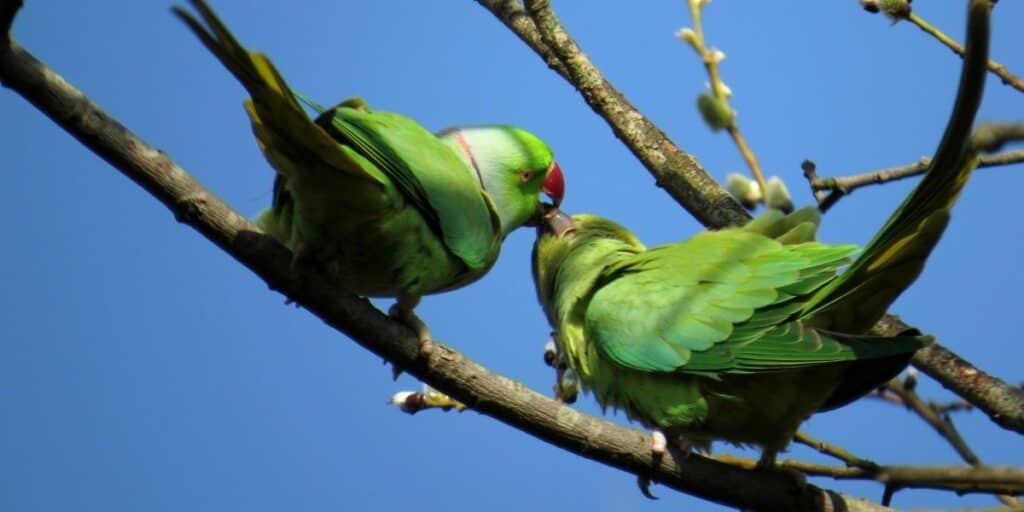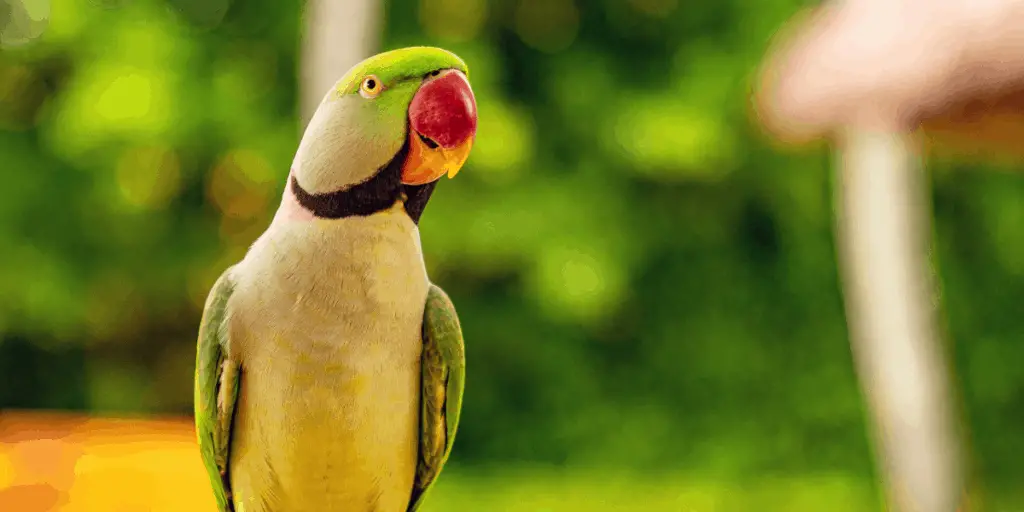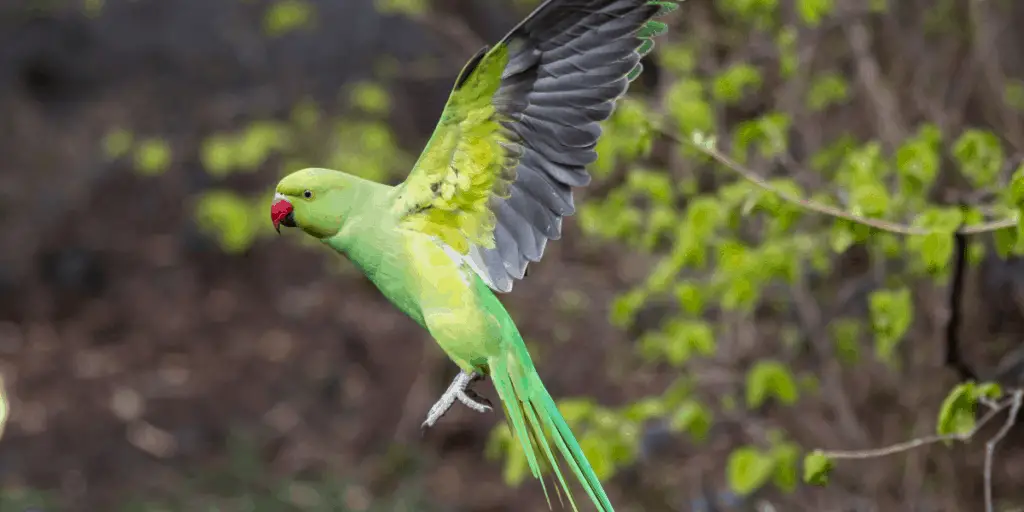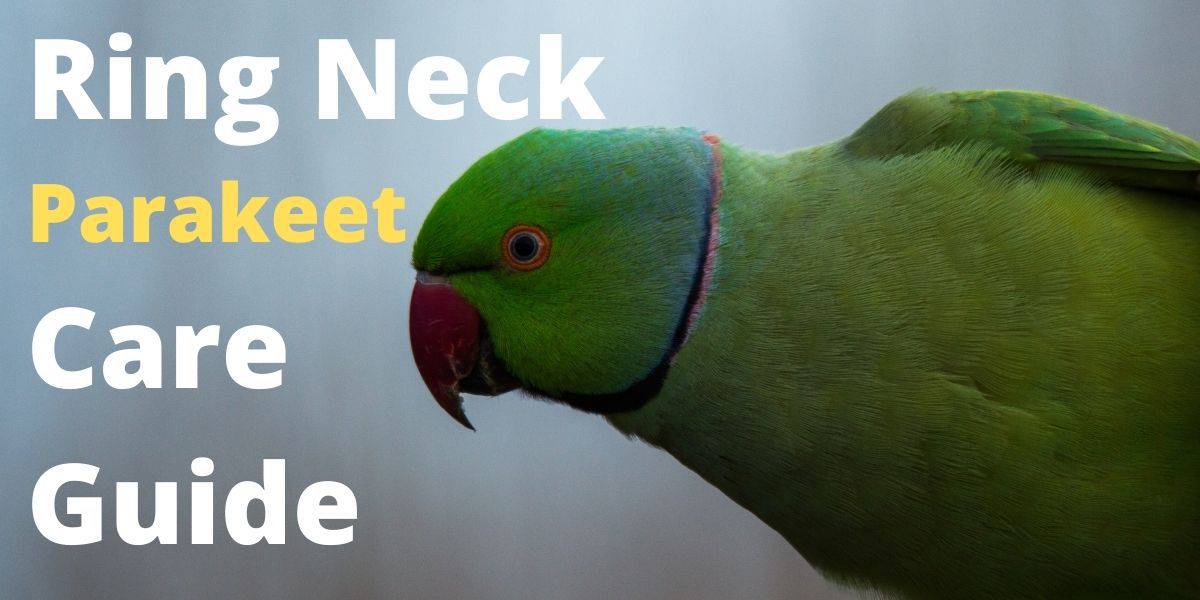Having a pet is one of the most significant commitments that you could undertake. It requires a lot of time, dedication, and care, regardless of the type of pet you have.
And although caring for pets can be time-consuming and expensive, you will have a life-long companion.
Bird keeping has become very popular in modern-day culture.
Who can resist that happy tweeting at sunrise and the cheerfulness of our chirpy friends throughout the day?
While others consider birds low maintenance pets, they require a great deal of care as they are pretty sensitive.
We all have different preferences in choosing the perfect ave to become a member of the family.
Some prefer the smaller breeds, while others enjoy the bigger or chattier varieties. Parakeets are the most popular pet birds.
While these birds are considered low maintenance, they are still an investment that needs good care, handling, and attention.
Below is a comprehensive guide to all things rose-ringed parakeets.

Table of Contents
The Rose-Ringed Parakeet
Before we get into the care and maintenance, let’s talk a bit about the parakeet.
Origins
Scientifically named Psittacula Krameri, the bird is said to have originated from North and West Africa and Southern Asia.
Its natural habitat ranges from dense forests to wooded savannas and even urban gardens. Rose-ringed parakeets enjoy a lifespan of between 25 to 30 years.
The birds are quite popular and were introduced to various parts of the world by different means.
Unfortunately, the bird is becoming extinct in some parts of the world and, thus, requires safeguarding.
How do they look?
Rose-ringed parakeets naturally have green feathers, although some have mutated and can be found in white, blue, gray, and yellow.
On the face, stomach, and under the wings, they have a yellow tone, with the nape and back of the head blue.
They also have a narrow pink stripe around the nape. On average, an adult parakeet weighs about 130g and is between 40 to 43 centimeters long from head to tail feathers.

Characteristics
Domesticated rose-ringed parakeets have earned themselves a reputation as the best talking birds and can attain a vocabulary of up to 250 words.
In the wild, the birds travel in flocks of hundreds or more and are, therefore, used to having company.
They are family-oriented and friendly and will bond with more than just one person in the family.
The birds also require less attention than other parakeet varieties and will make do with about thirty minutes of daily interaction to remain friendly.
If constantly neglected, rose-ringed parakeets may develop undesirable characteristics like extreme aggression.
Temperament
Parakeets are known for their charm and intelligence. Although not particularly affectionate, the birds make for great companions.
The females tend to bond quickly with their owners, while the males are generally easy-going.
They are eager to learn new things and will excel when they are intellectually challenged.
They will thrive when regularly handled and loved, but will engage in destructive behavior such as biting, excessive chewing, and feather plucking if they are bored or depressed.
The birds are also great at alerting when danger is looming by making loud calling sounds. Talk about a handy alarm system!
Owners of this bird variety should note that the bird can go through a hormonal stage known as “bluffing.”
During this phase, rose-ringed parakeets tend to be aggressive.
Although this period may be challenging to the owner, it lasts a few weeks, and your bird will return to its usual attractive personality.
These birds also do not take scolding well as they may develop a lifetime of fear of people.
They instead respond to positive reinforcement than to negative tones and harsh words.
Can Rose-ringed parakeets talk?
These birds are renowned for their vocal ability and are considered among the top talking domestic birds.
On average, they start speaking between the ages of 8 months and one year and reach a vocabulary of over 250 words.
They are brilliant and quick to learn when it comes to speech.
Best habitat for Rose-ringed Parakeets
If you are keeping the bird in a cage, it will require a long and spacious cage that allows for regular free movement during the day.
Recommended dimensions for a cage that houses one parakeet are 18 by 14 by 22 inches, but you can make it bigger for your bird’s comfort.
The cage bars should not be too broad as there have been instances where parakeets got stuck in between cage bars.
When choosing a cage, take into consideration the construction material.
Rose-ringed parakeets use their beaks to climb up the bars and ingest bits of material from the cage bars.
If the cage is made of lead or zinc, your bird may eat the toxic material and get sick or even die.
The cage needs to be located in an area that allows for interaction — away from direct sunlight and draft.
If you intend on keeping a small flock, it is recommended that you construct an aviary rather than keep all the birds in a cage.
For breeding purposes, nesting boxes are most ideal as the birds prefer to nest in cavities.
Rose-ringed Parakeets Dietary needs
Just like you need a balanced diet to grow and thrive, so will your bird. You must feed your parakeet a diversified diet which includes:
- Small mixed seeds
- Buckwheat
- Oats
- Safflowers
- Sunflowers
- Green leaves
- Seeding grasses
- Fruits such as apples, oranges, or bananas
- Kibble
- Nectar from flowers, and flowers too
- Berries
- Give nuts but in limited quantities and only as a treat.
The domestic birds also enjoy cooked food like chicken, beans, grains, and rice.
Avoid the following foods in your bird’s diet as they may do more harm than good:
- Oils
- Salts
- Avocados
- Rhubarbs
- Chocolate
- Alcohol
- Excessive citrus fruits, as this will lead to iron overload disease ( vitamin C increases iron absorption)
Fresh, clean water is also essential for your bird’s good health.
Change your birds water and food on time and ensure that you clean the water and food bowls regularly.
Mental and physical fitness for parakeets
Rose-ringed parakeets are naturally active and will require adequate space for flying.
Constantly keeping your bird caged is not ideal. You need to create a safe playing and stretching area for your feathery friend.
Three hours of play and stretch per day should suffice. Rose-ringed parakeets are known to be enthusiastic chewers and climbers.
Chew toys are also essential for the maintenance of your parakeet’s jaw muscles.
Get safe chewable toys and wood that your bird can nibble on. These will need to be replaced regularly. Clean pine cones can also be a suitable substitution for chew toys.
Parakeets also enjoy push and pull toys and foot toys. Having a variety of colorful toys will keep your bird enthused for longer.
Rotating toys is also stimulating for your caged pet as it helps prevent monotony.
Climbing ropes, ladders, and swings will also enhance your parakeet’s good health as these motivate regular exercise.
As parakeets are rather intelligent birds, you can keep them mentally stimulated through puzzles and other complex toys. It is a worthwhile investment for your clever birdie.
Your bird will want to keep clean, so a shallow splash bowl is ideal for this. If your bird is housed outdoors, misters will help it clean up and stay refreshed.
Cage care for your bird’s home
A healthy, happy home makes for a healthy and happy bird. Your bird’s cage should, therefore, be maintained in tip-top condition.
Understandably our lives are a lot busier, and it can be overwhelming making time to clean up after your bird.
However, this is an essential part of bird care, and consistency is vital. There are daily, weekly, and monthly tasks to keep your bird’s home suitable for living in.
Here are some handy tips that will help get the job done:
- Before embarking on the cleaning process, it is crucial to invest in suitable cleaning detergents. Some artificial detergents may be harmful to your bird, so try and keep things natural.
If you find organic detergents to be on the pricey end, consider DIY solutions. One such detergent is a mixture of water, baking soda, and lemon juice.
- Water and food bowls require daily washing to avoid the build-up of bacteria and fungi, which will be harmful to your bird.
- Cleaning your bird’s home from the top downwards is a handy tip that will ensure all dirt is removed and get the job done fast.
- Investing in the right tools will also make cleaning more accessible and more efficient. For example, microfiber cloths are excellent at trapping dust and other particles, while bottle brushes and toothbrushes will efficiently clean in between the bars of your birdcage.
- You need to manage bird droppings to keep your bird healthy and your cage area clean. If you line the bottom of the cage with parchment paper or other material that can easily catch droppings, you simply fold, roll and throw it away. You can do this twice a day without too much labor.
- Your bird spends a good amount of the day rested on the perch. Therefore, the perch needs to be kept clean to avoid unnecessary sickness to your bird. You can wrap it in an absorbent material that can be unraveled and replaced daily.
- Toys and other accessories in the cage need to be cleaned regularly, possibly once a week.
- Once a month, take time to hose down the entire cage outdoors. Investing in a steamer will also be handy for cleaning and sanitizing your bird’s cage.
Rose-ringed parakeets’ health concerns
These birds are generally hardy, resilient and adaptable, and are overall low maintenance.
A healthy parakeet will have a healthy appetite, especially in the morning, be physically active most of the day and spend time grooming and smoothing its feathers daily.
If your bird suddenly has a subdued appetite, or is still for a prolonged period, or has missing feathers and is not consistent with his grooming schedule, chances are your bird is unwell.
Parakeets’ feet are susceptible to a variety of diseases. As a bird owner, be on the lookout for any changes to the appearance of their feet, like encrustation.
Claws should also be kept short and clean to avoid disease.

On average, your rose-ringed parakeet will have a temperature between 102 and 112 degrees Fahrenheit.
If your bird feels warmer than this temperature range, it will likely be unwell.
No one knows your bird better than you, so keep your eyes open for any uncharacteristic changes to your pet.
A regular visit to the vet will do your bird good as any health concerns will be identified sooner rather than later.
You can also utilize the vet visits to groom claws and feathers properly.
It’s not recommended to try and do DIY, as improper trimming of feathers may result in hemorrhaging.
While these birds are generally fit and will rarely have significant health concerns, they may succumb to specific ailments which an owner needs to be on the lookout for.
Some of these include:
- Polyoma
- Sacrosystosis
- Aspergillosis (fungal)
- Bacterial infections (pneumonia
- Hypovitaminosis A
- Psittacosis
Rose-ringed parakeet lifespan
Rose-ringed parakeets typically live for between 25 to 30 years. However, some will live up to 50 years.
In the wild, the birds are used to extreme conditions, from hot arid regions to colder areas such as the Himalayas.
As such, they are tough and adaptable and enjoy a long lifespan.
If you give your domesticated parakeet adequate care and attention, it will generally have a long lifespan.
There you have it, your guide for Rose-ringed parakeet care that will make tending to your pet easier and enjoyable.
A healthy, happy bird is an active and chirpy bird you’ll enjoy for years to come.




